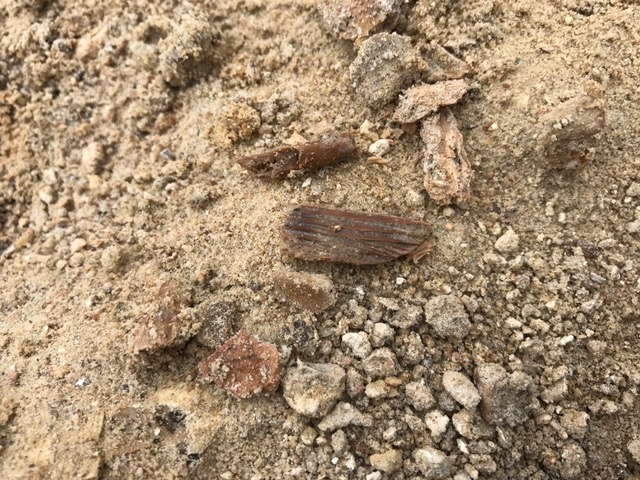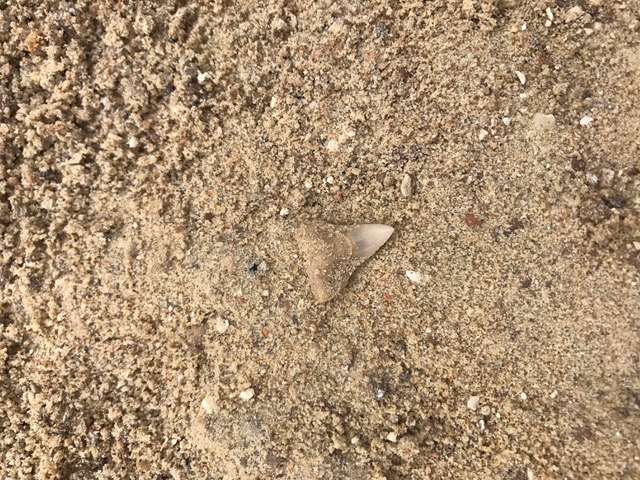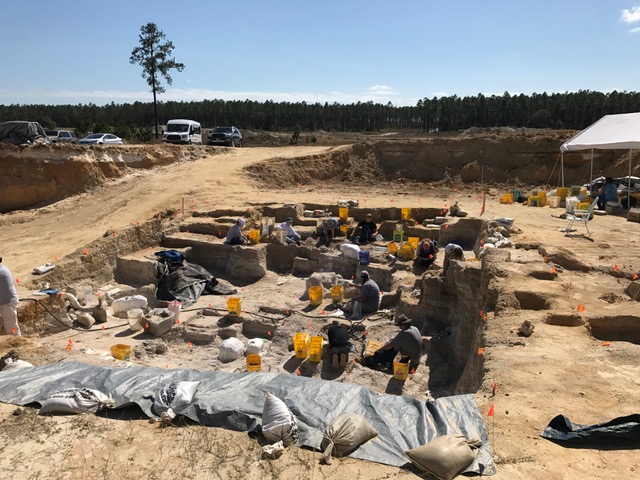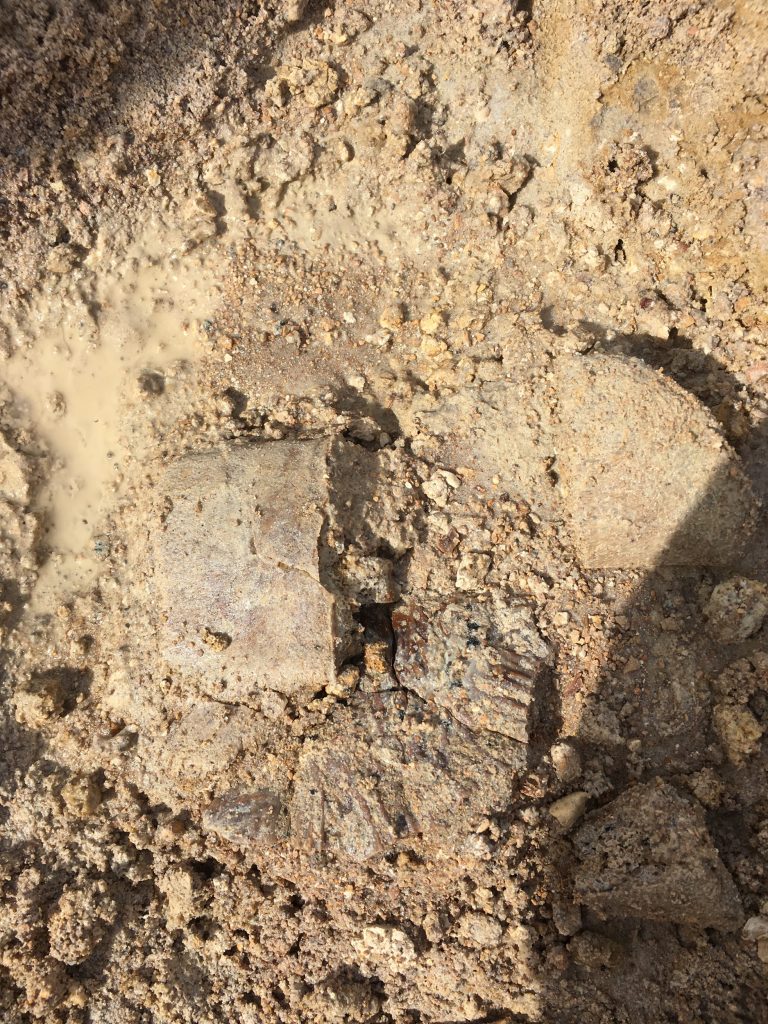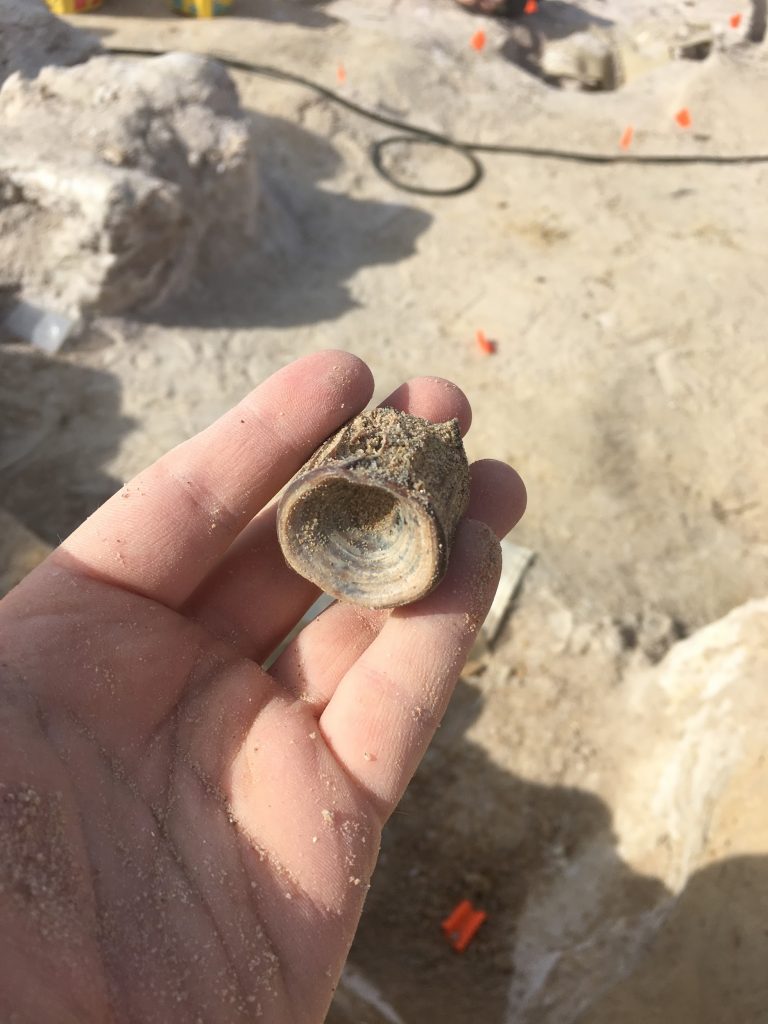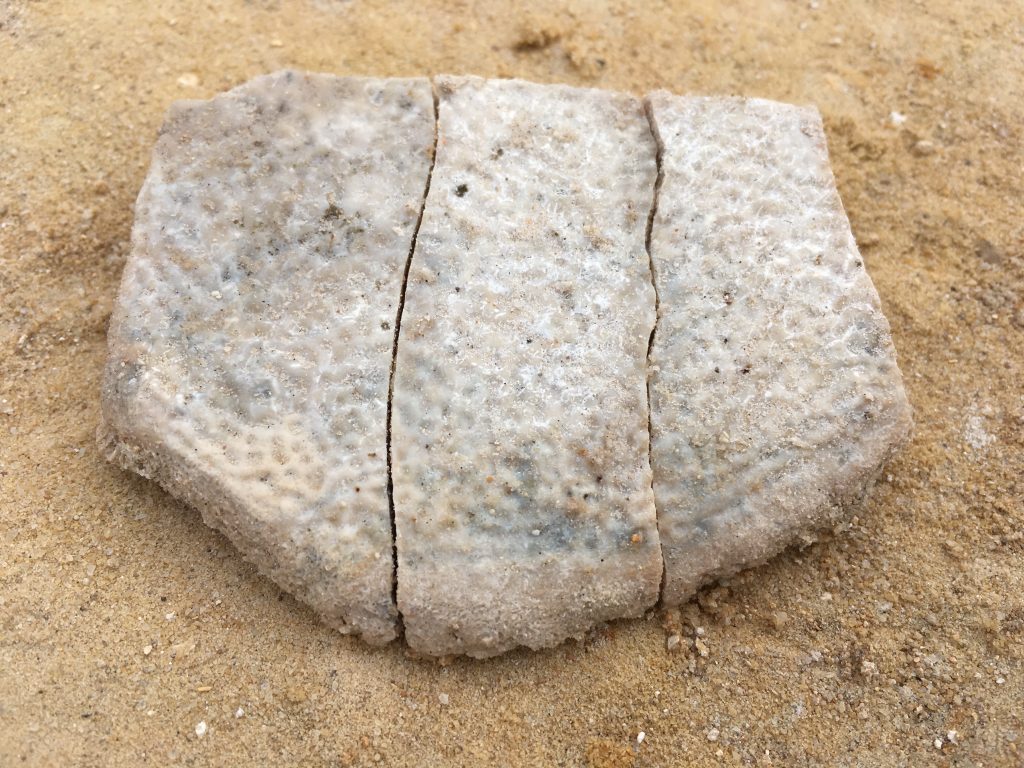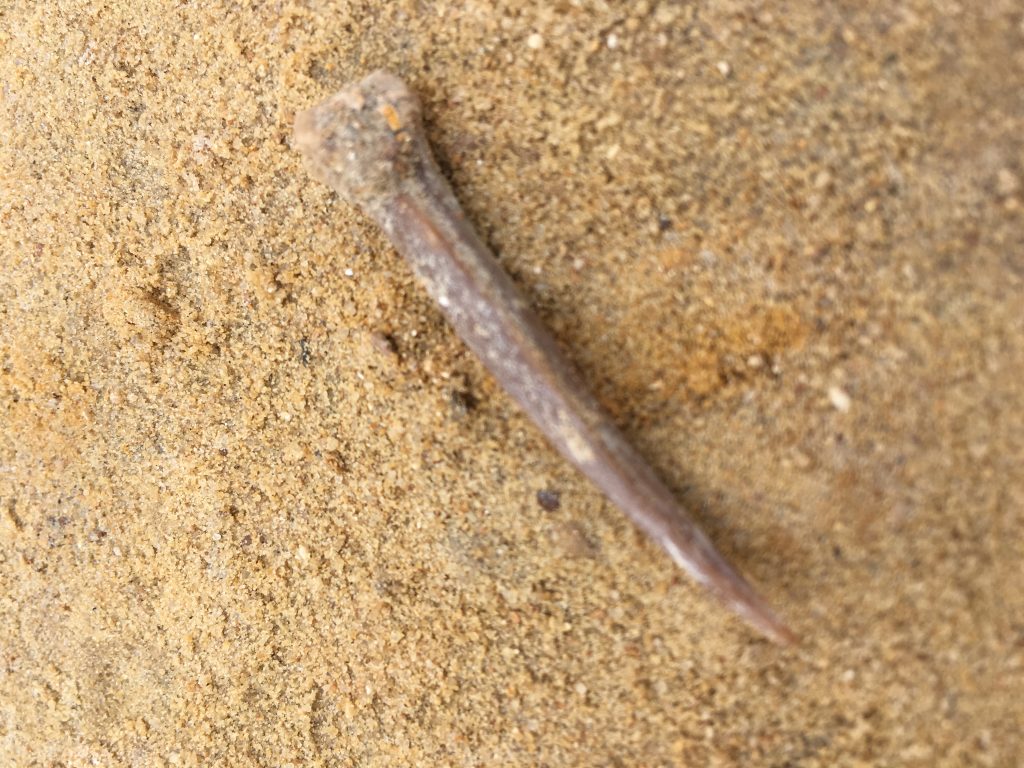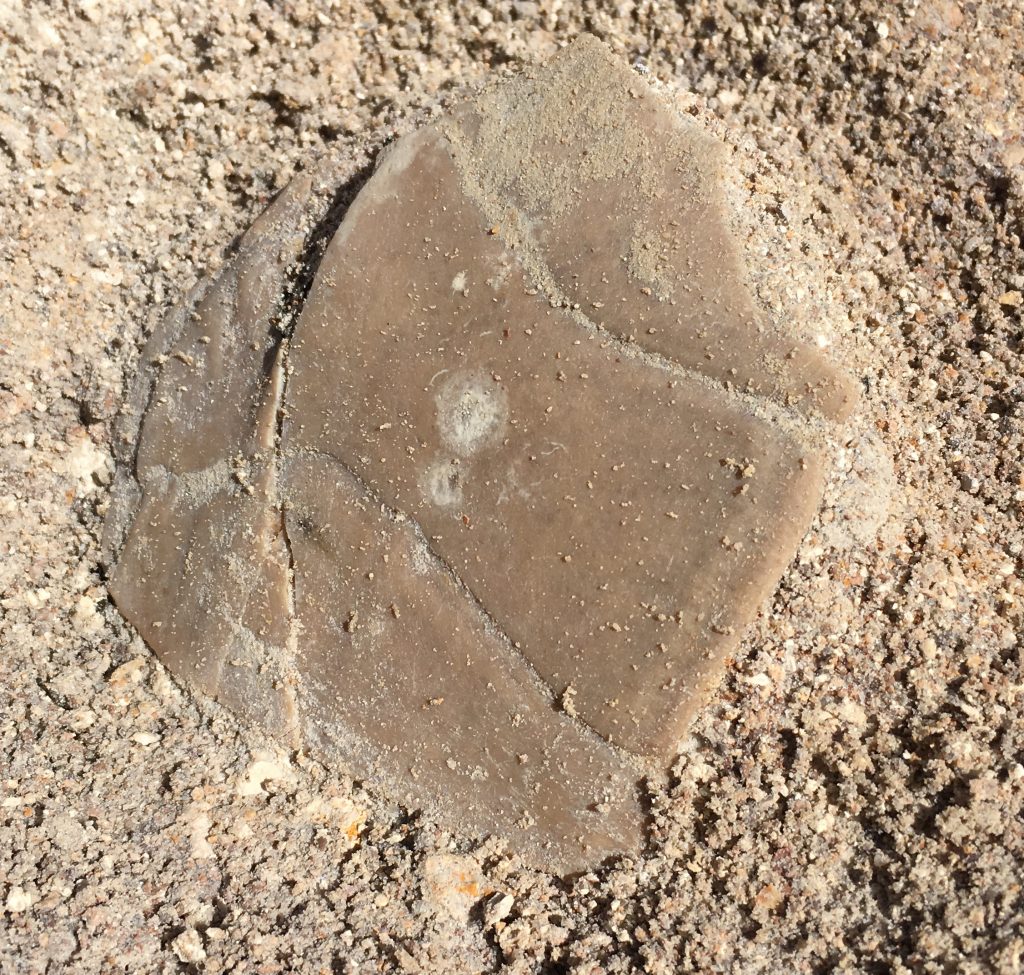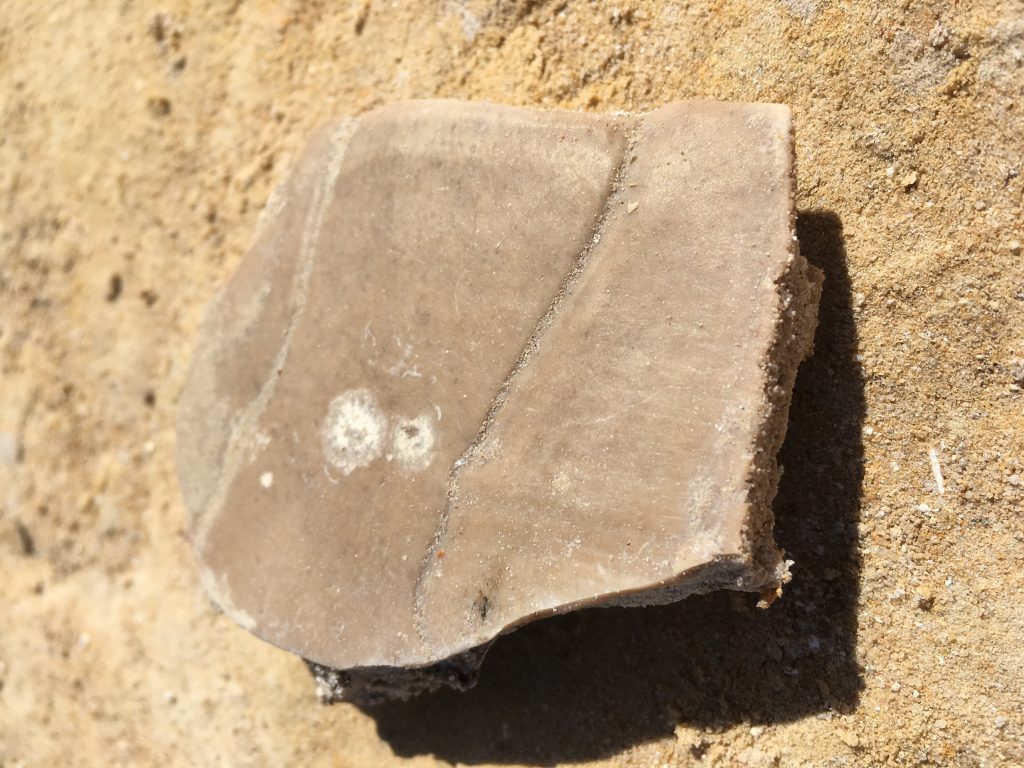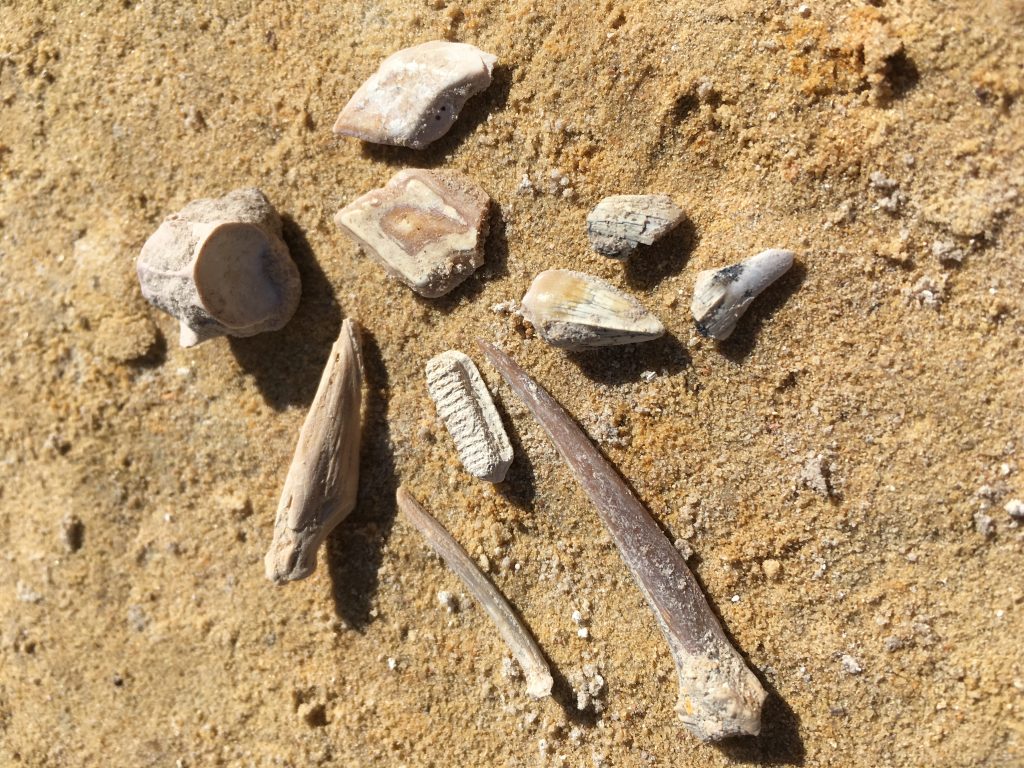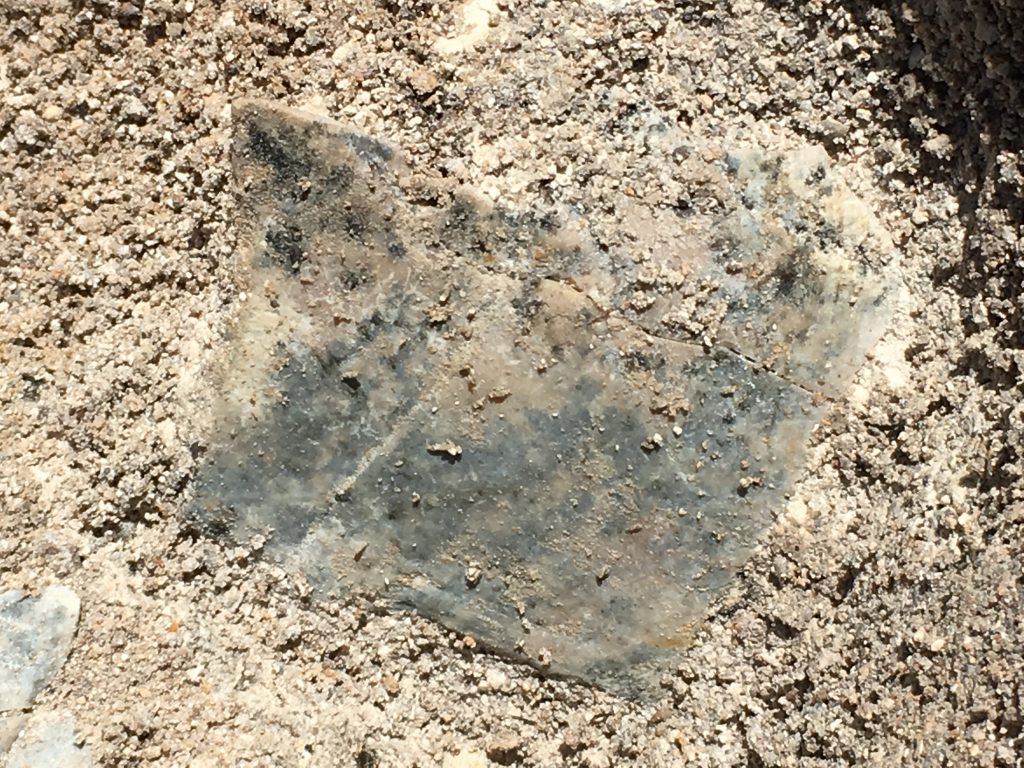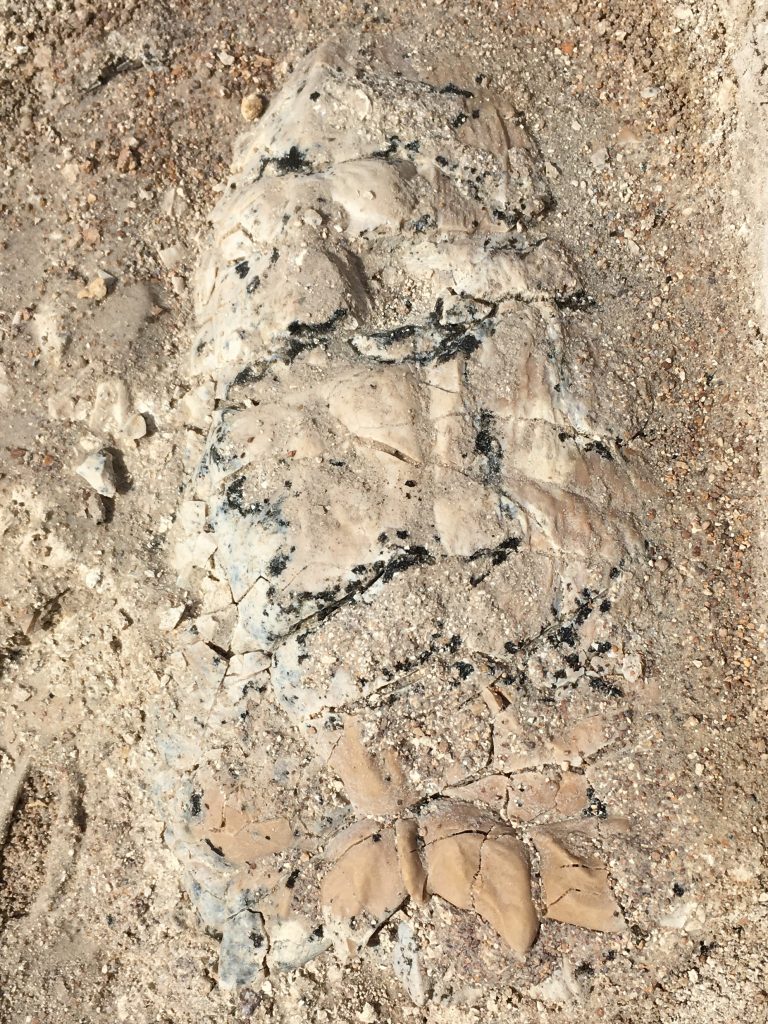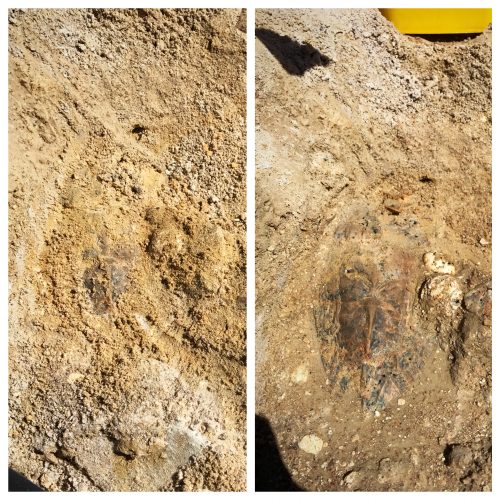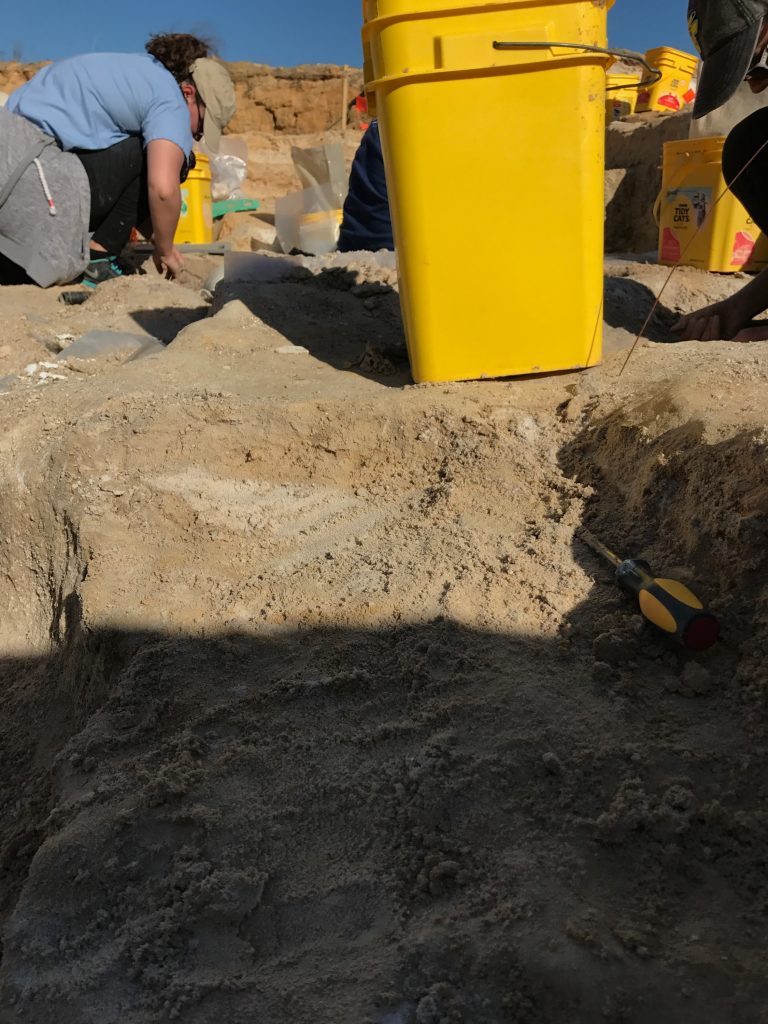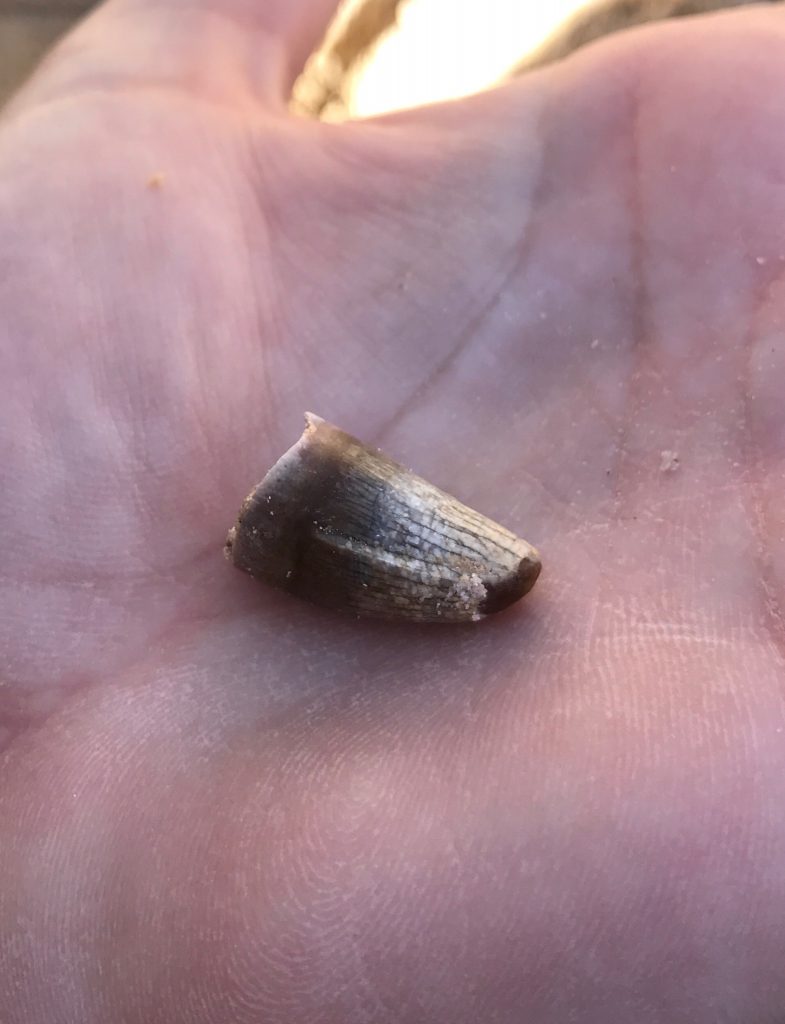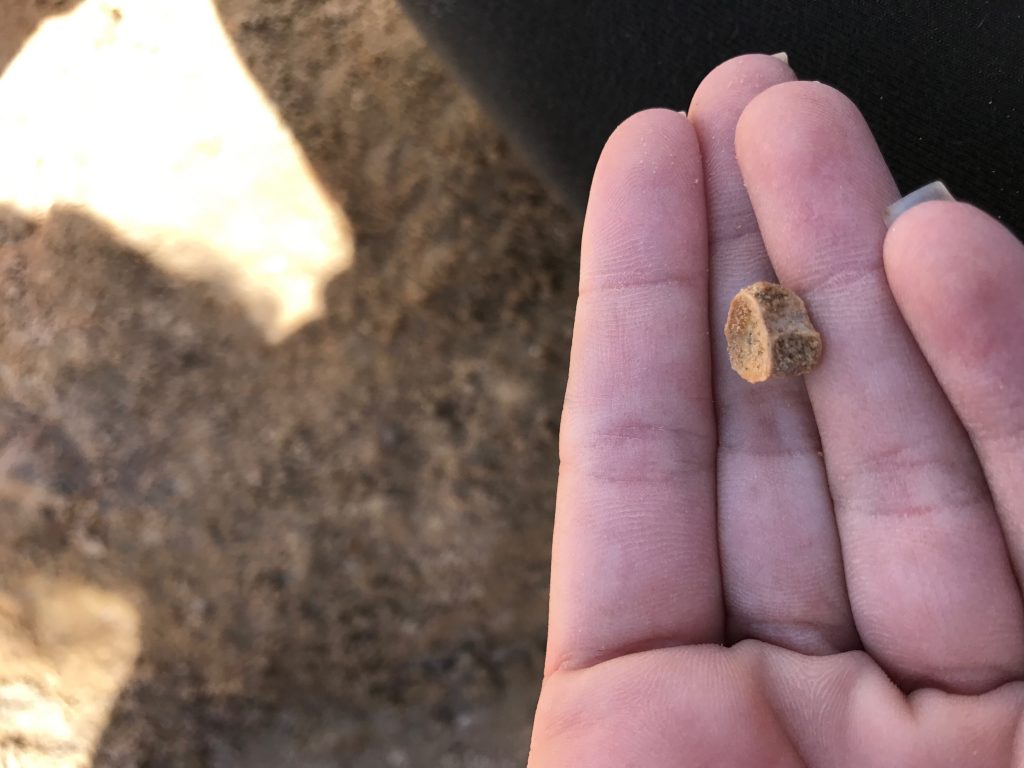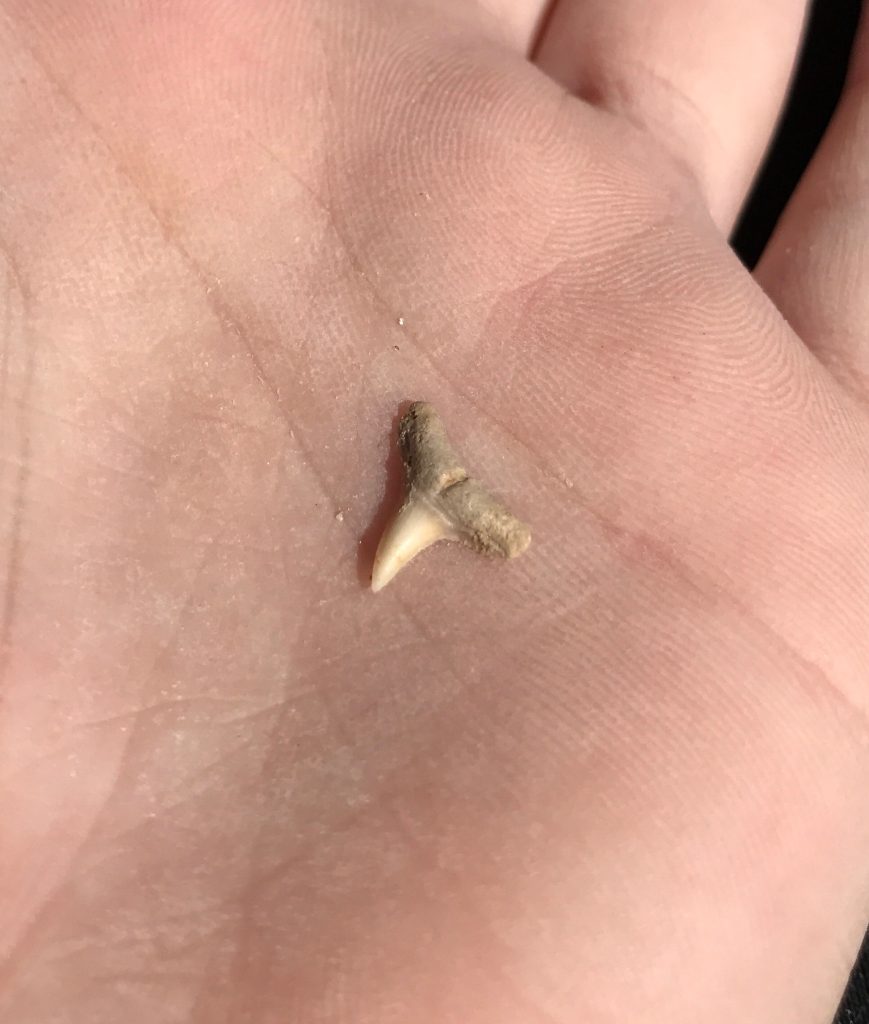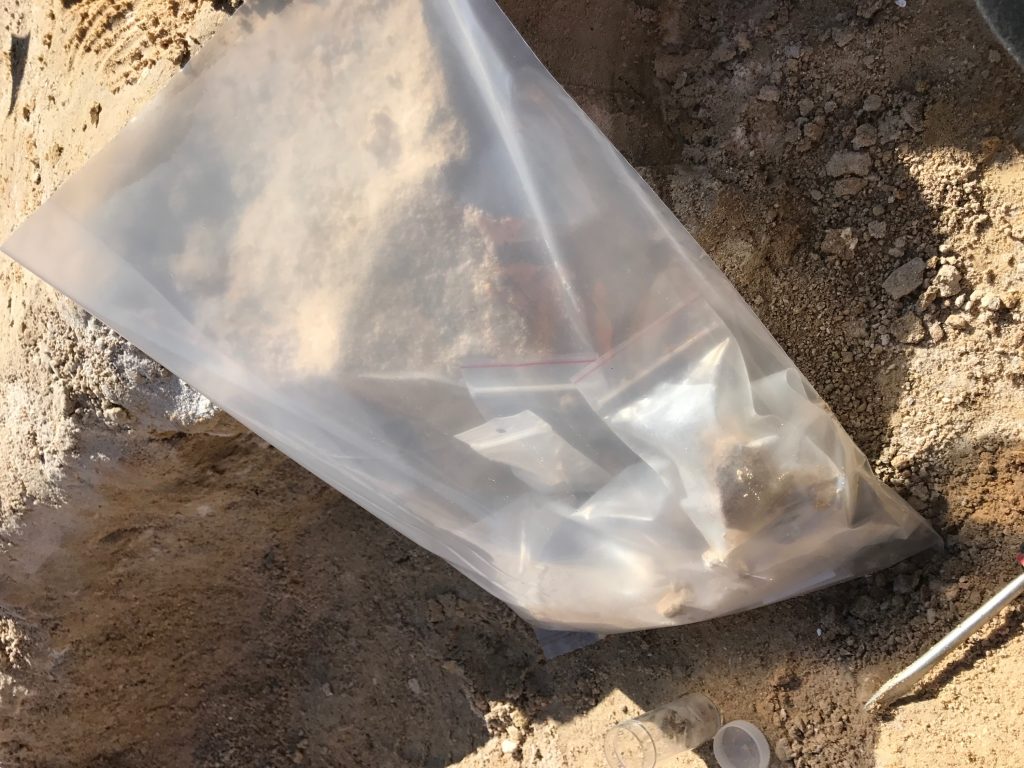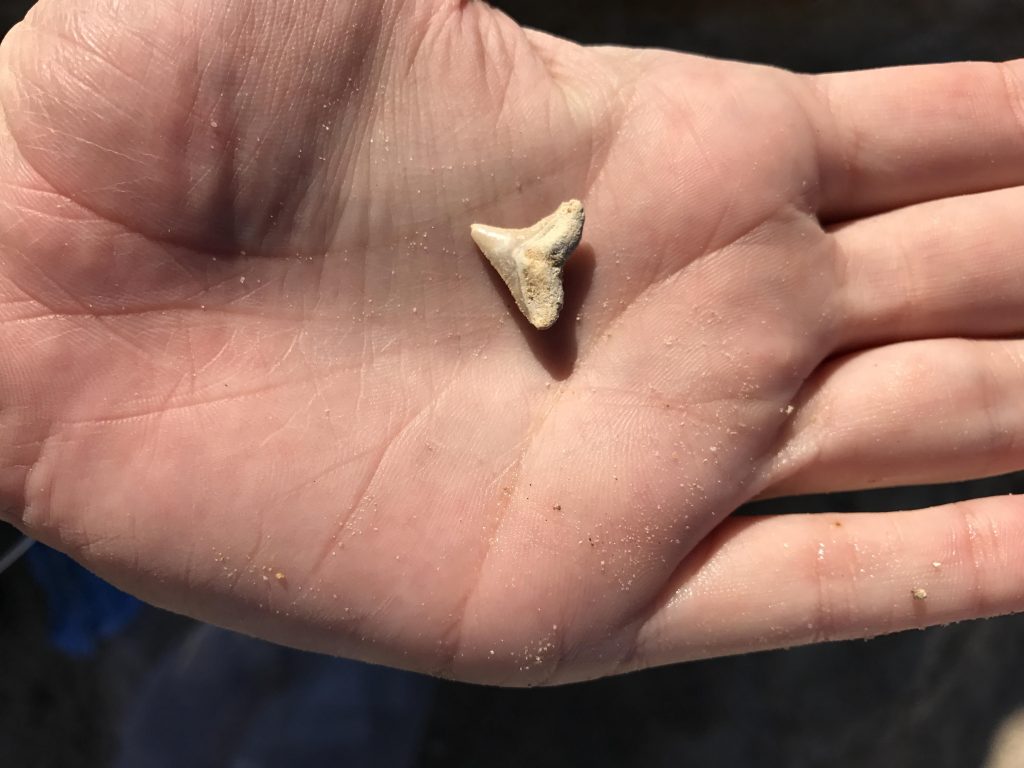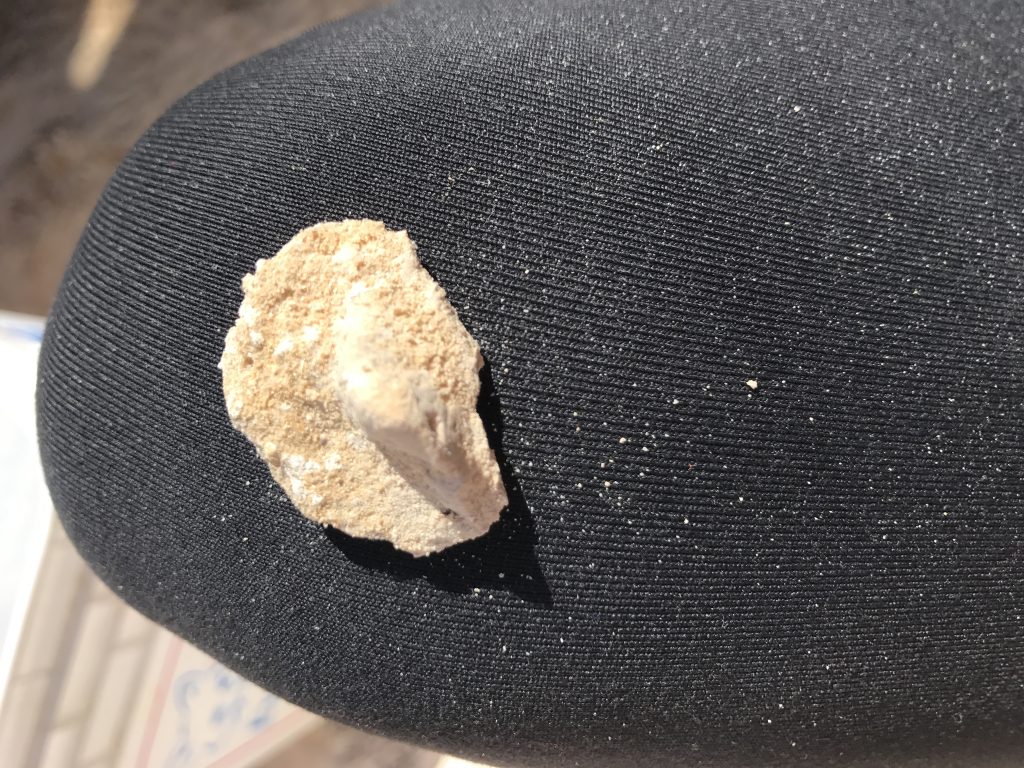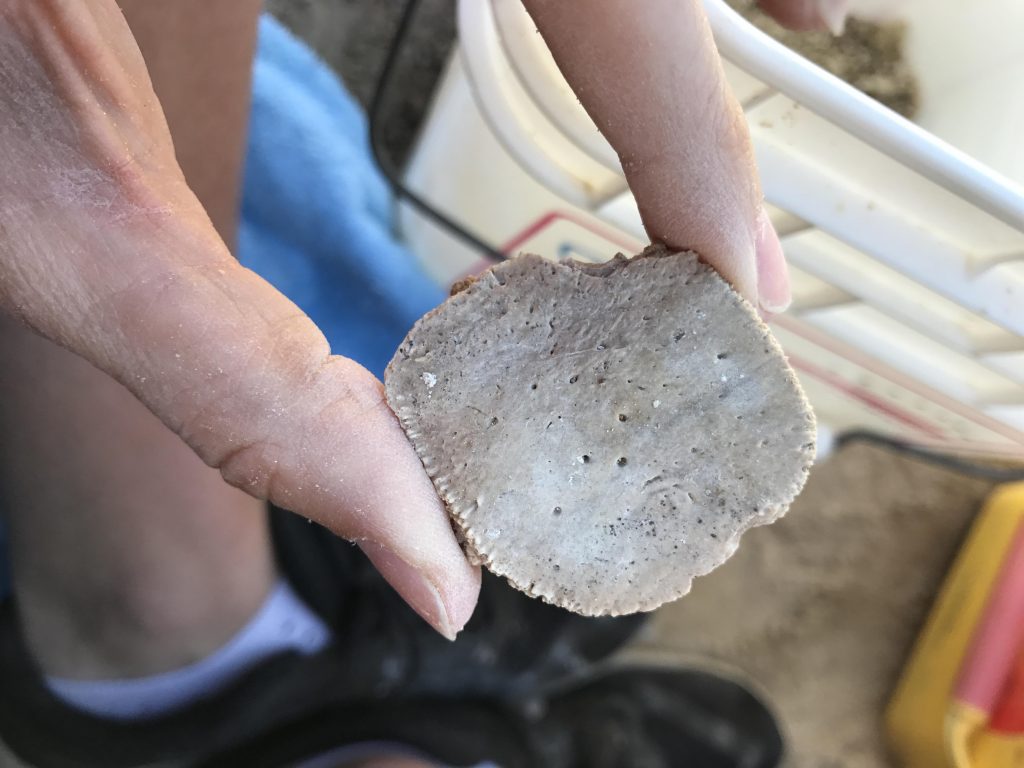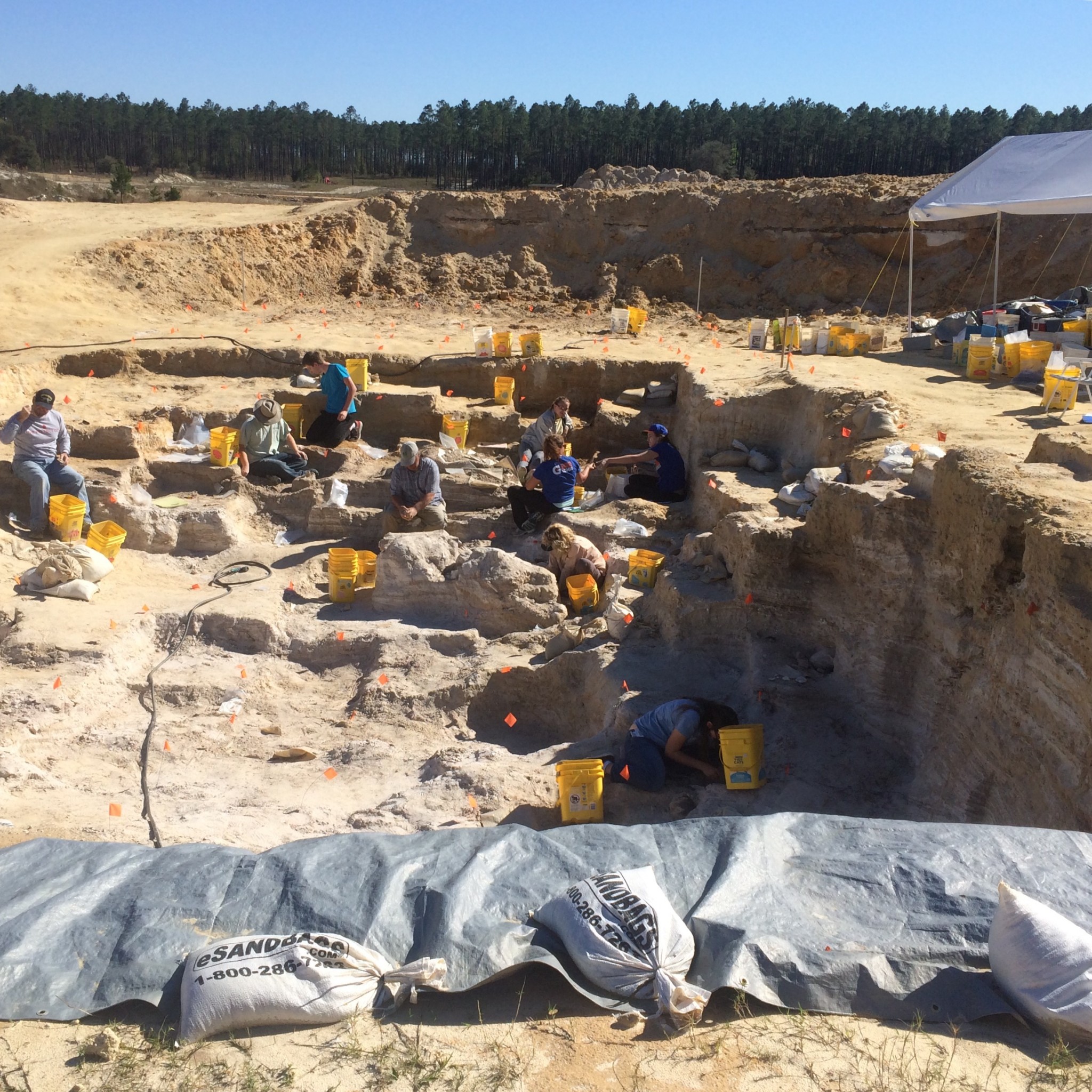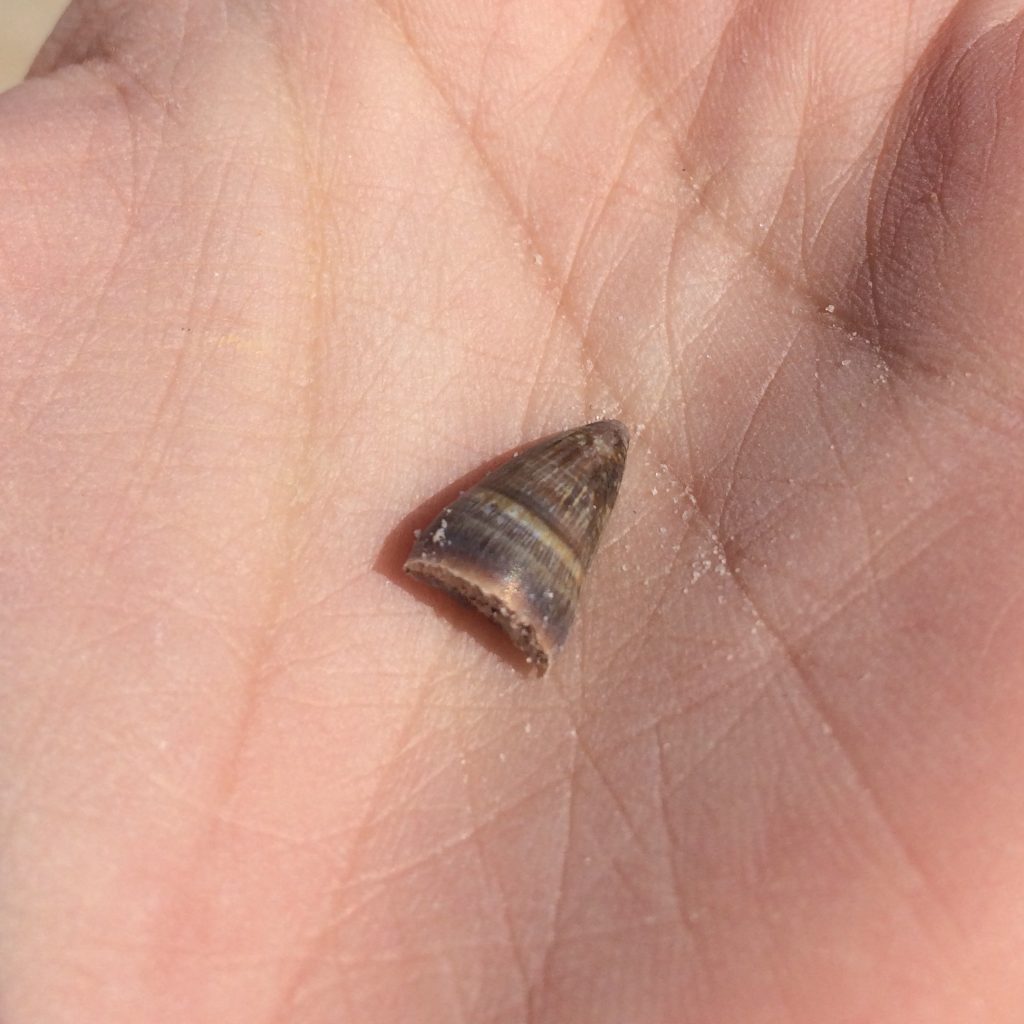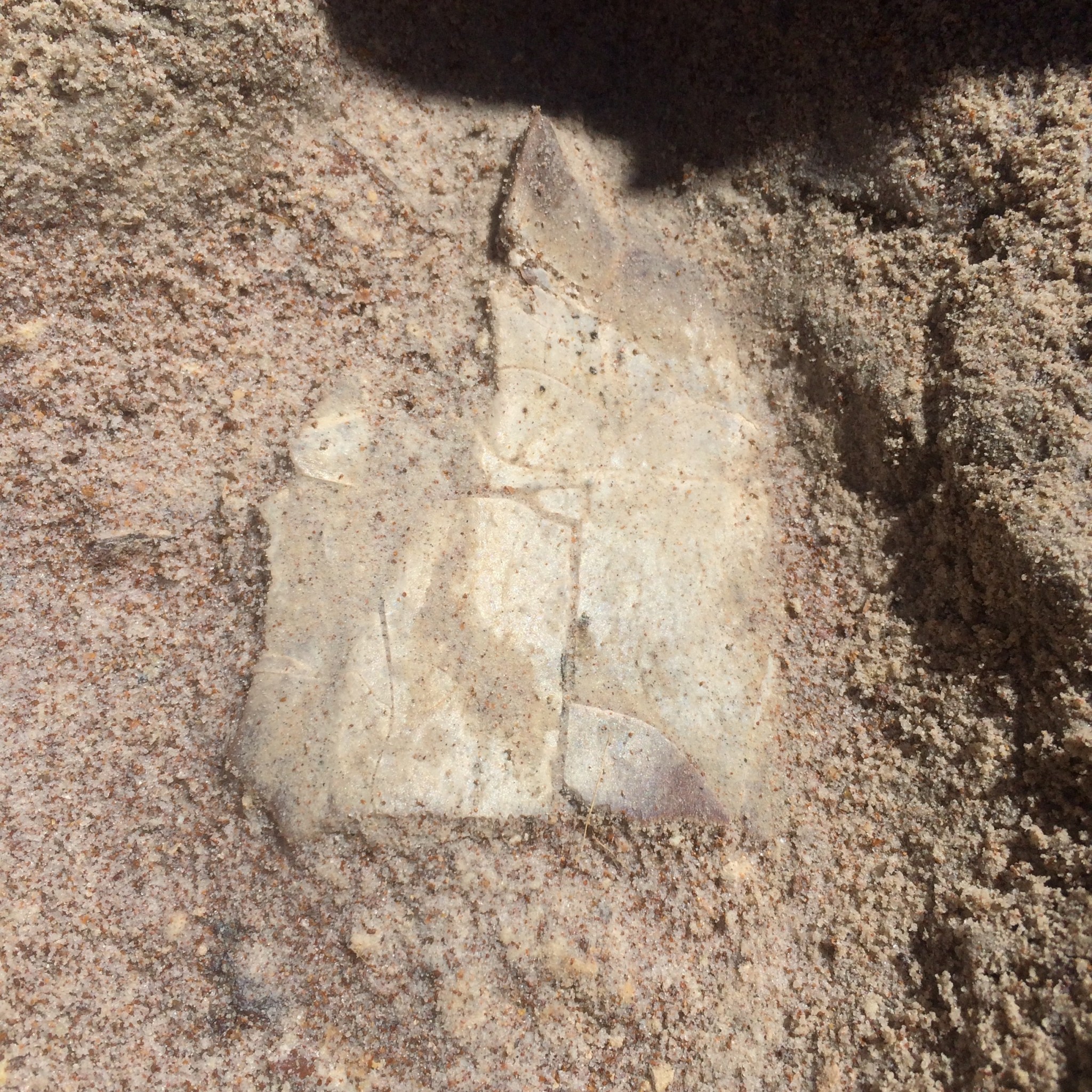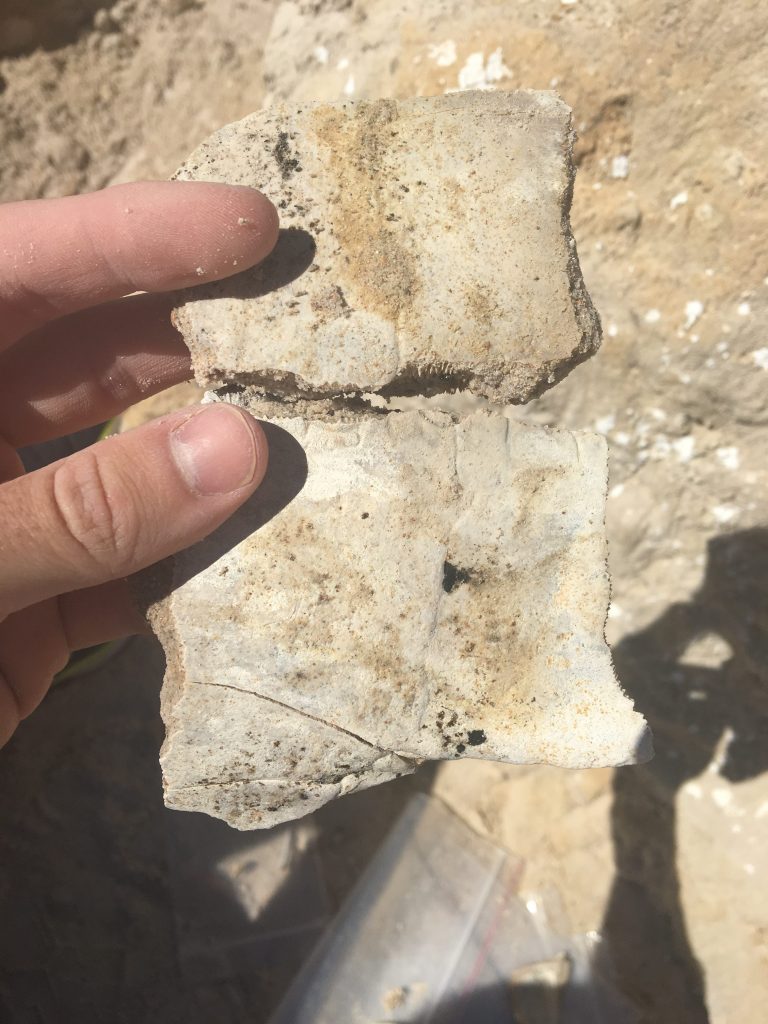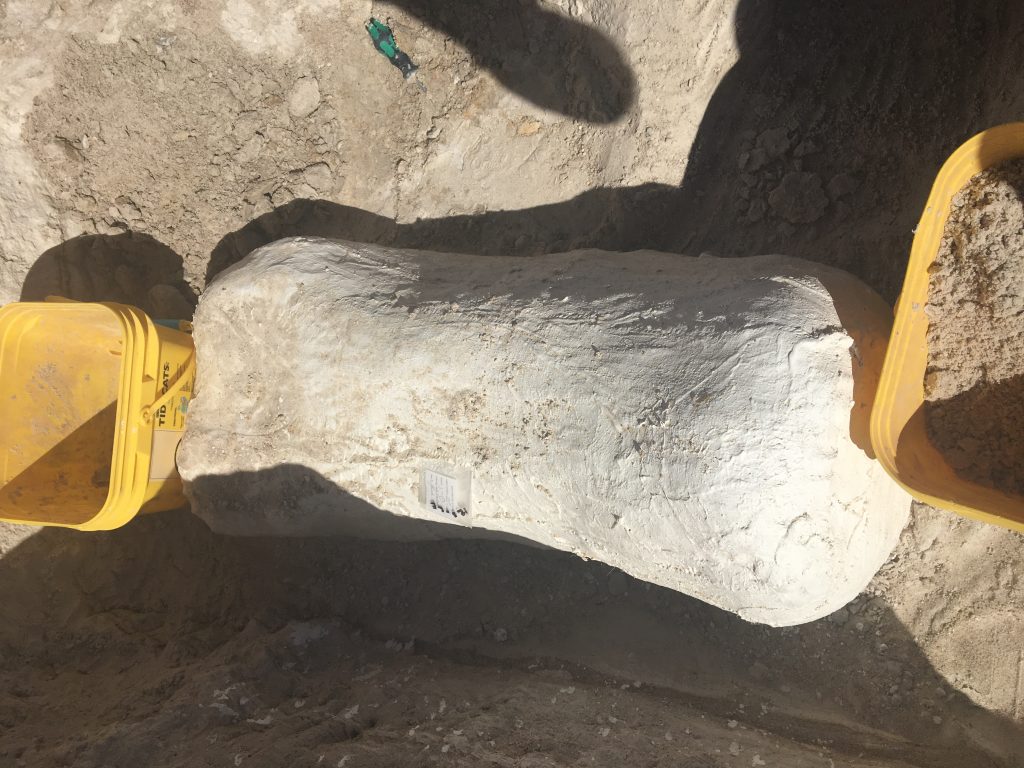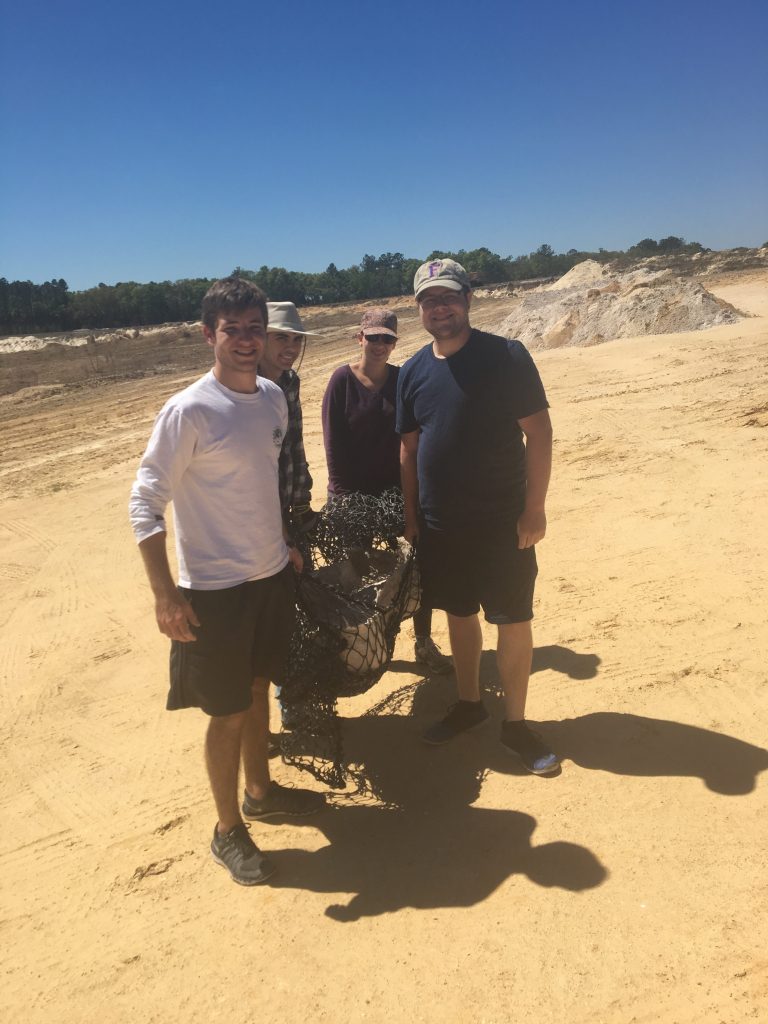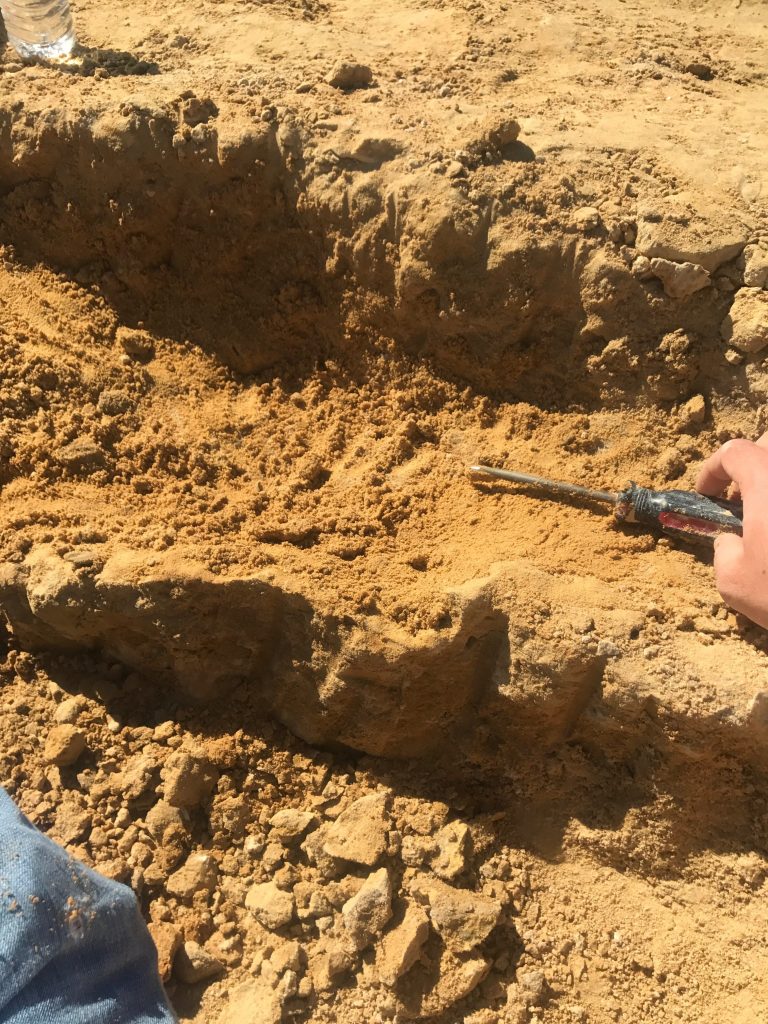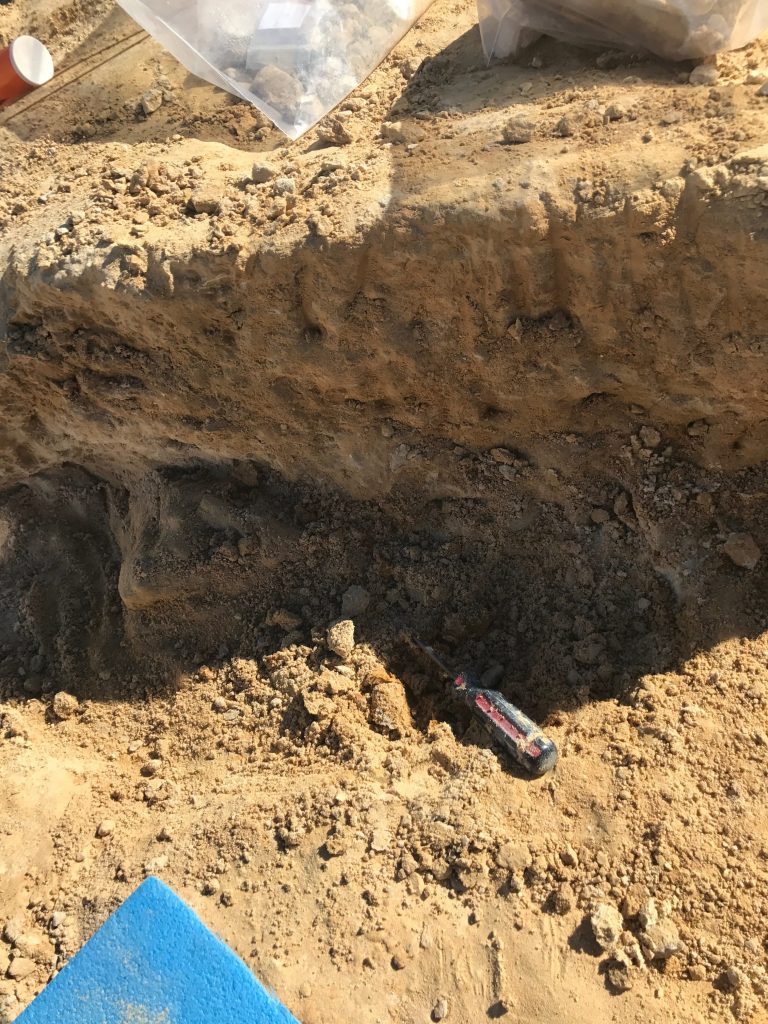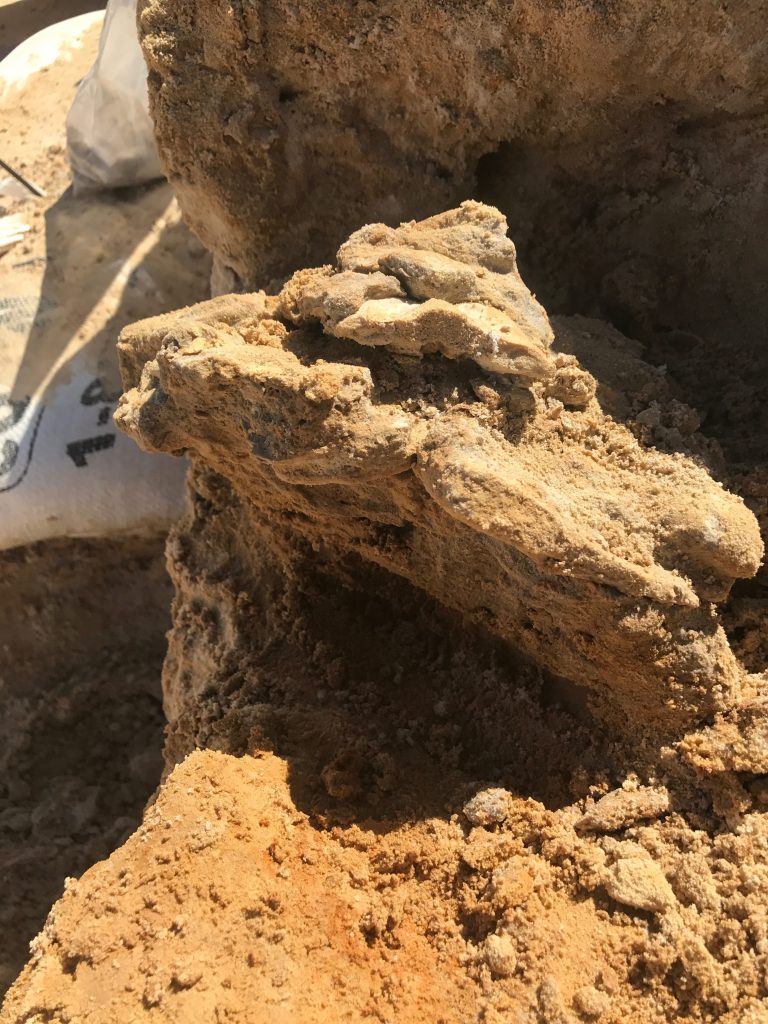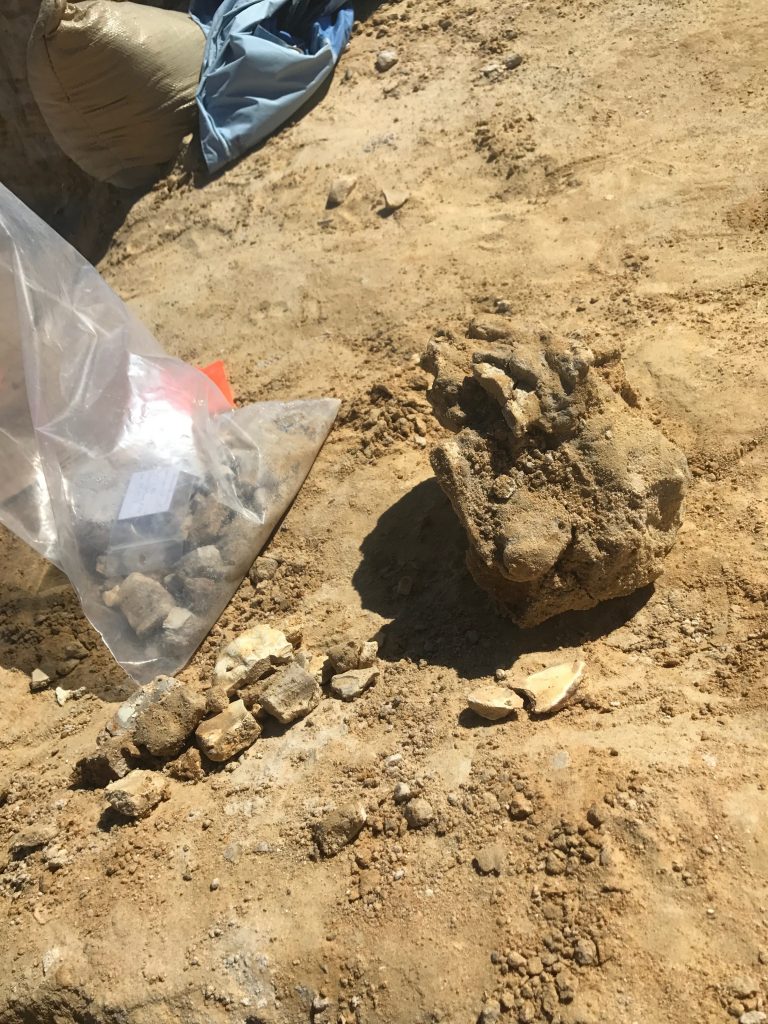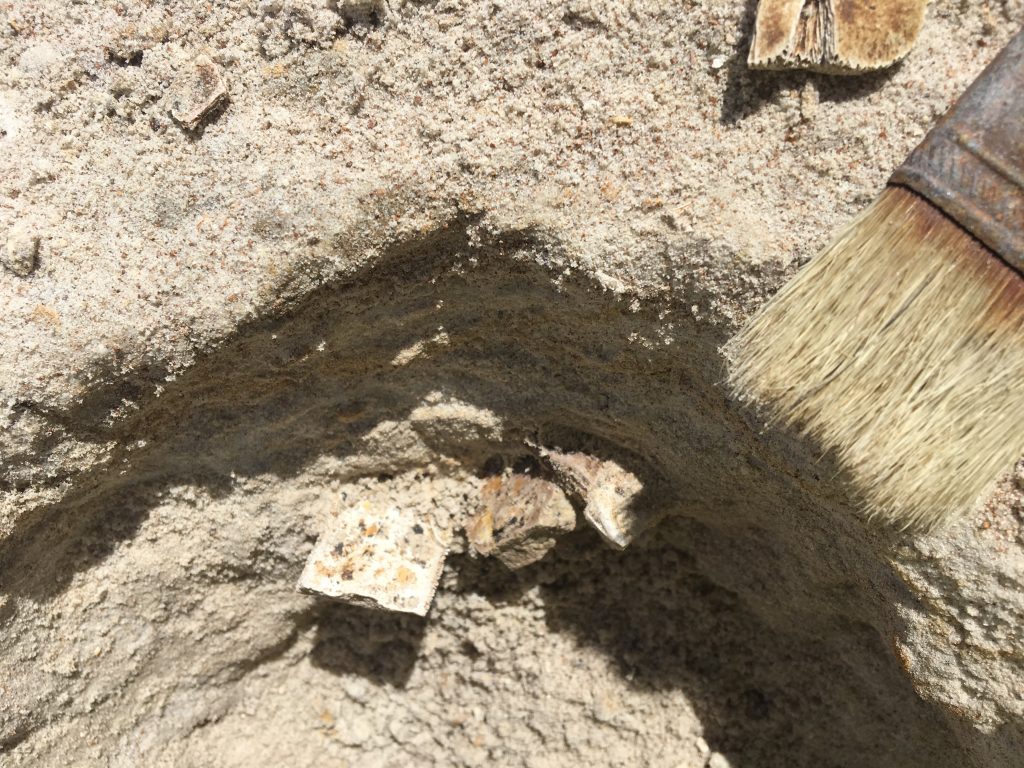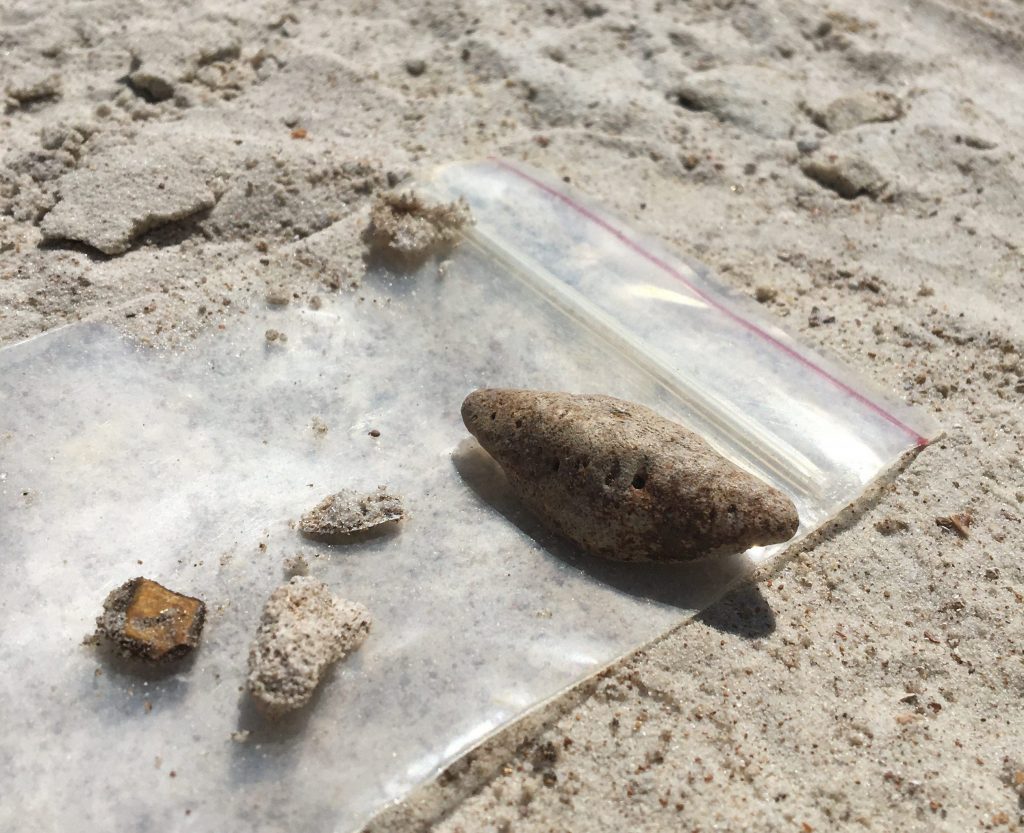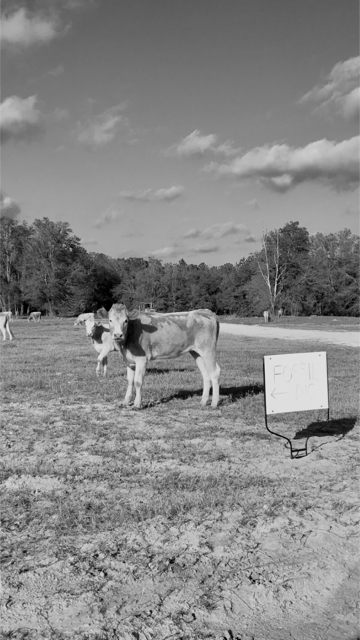
For first impressions of a paleontological dig, check out our Day One post.
Sunday, February 12th
“This past Sunday at the Montbrook site proved to be more productive for me than the previous dig. I was digging in a higher layer of stratum and my meter-by-meter square contained a wide variety of fossils. In the morning I found a large alligator scute which I initially thought was another piece of turtle shell since I was digging in the “turtle death layer.” Throughout the day I found lots of little fish bones but they were very soft and fragile so most of them broke apart even though I was being careful.
“In this layer, we kept the dirt we were digging through and put it into bags that would be taken back, rinsed and looked through more carefully. At the last dig, it was mostly soft sand with little chunks of clay but this dirt was coarser and seemed to be small fragments of fossils that had collected in this layer through a stream. The most exciting discovery of the day was my shark tooth I found near the end of the day. It had serrations and was bright white in color. I’ve found shark teeth before on Venice Beach and they were dark in color, but finding a shark tooth in the middle of Northern Florida surrounded by pine trees and beef cattle really makes me wish I knew what that area had looked like 5 million years ago. A little later on I found another shark’s tooth which I suspect was from a different species because it was smaller and rounder, angled to the side, and lacked serrations.” – Storm Wittenberg
“Today I was assigned to one of the upper levels, to dig through a layer rich in turtle fossils. In terms of smaller finds, this spot wound up being much more lucrative than digging around the scapula last week. I wound up uncovering fragments from the shell of an Alligator Snapping Turtle (first picture), plus parts from a Slider Turtle. Getting these fossils out of the clay was difficult, because they had already fractured. While the Snapping Turtle fragmented into many pieces, I was able to get the Slider Turtle shell fragment out mostly unharmed.
“Towards the end of the day I started to find more in the way of fish bones, including a particularly large vertebra from a Black Drum (second picture) and some fin spines from the same species. Finished off with an osteoderm from an alligator, a bone that functions as an armor plate within the skin of a crocodilian. Bagged far more fossils in total this week, and looking forward to going back.” – Ben Rumsey
“Today was a day of Turtle shells. Shells on shells on shells. I’ve come to realize that that’s just the way things go when digging in Montbrook’s red/grey clay/sand/gravel layer 2a material, aka “Turtle Death Layer” In my two trips to Montbrook so far my first fossils of the day have been small and long-bone in nature but each day has quickly evolved into a veritable brawl between screwdriver, turtle shell piece and all the surrounding media holding it all together. Today I got lucky and hit the crest of a complete slider type turtle carapace and subsequently unearthed its rear half to expose the pointed perimeter scutes of the shell. That was the most exciting find, but I also got a turtle vertebra, a nice Black Drum spine, two very colorful Gar scales, and many many more fragments of turtle shell. A very productive day indeed, not including the heftiplaster jackets and numerous dirt buckets!” – Erich Zellmer
Sunday, February 19th
“Today, Sunday, February 19th, was my second ever fossil dig. For my previous dig, I was located on a very high layer of the site, which meant few fossils and lots of dirt. This time, I was lucky to be placed at a lower level, scientifically known as 2A, and more commonly known as “the turtle death zone.” However, as someone who did not encounter many fossils last time, I was happy to be located in a denser layer.
“My one meter by one meter square already had a large turtle shell that had been excavated around. It also had a large shelf that covered half of the square. The shelf sat about a foot higher than the rest of my square. My goals of the day were to first uncover a second turtle shell in my square, and then start to take down the shelf to make my square level. I made decent progress with unearthing the beautiful turtle shell that can be seen in the side-by-side image. As for the shelf, I was only able to take it down about four inches, which was not a huge difference, but hopefully the next person to dig there will have an easier time.
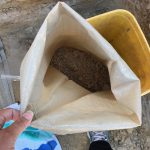
“Another unique thing about today’s dig was learning about bagging “the matrix.” This ultimately means saving the gravel-like sediment from your square in a specific bag, rather than just discarding the sediment that surrounds the fossils to a large hill located a few meters from our large hole in the ground. For me, it was still a learning day, but nonetheless very interesting. I am still working on my ability to distinguish meaningful bones from useless rocks, while figuring out the most efficient speed to dig. Some of my favorite finds that can be seen in the photos are a tiny shark’s tooth (about a centimeter wide), an alligator’s tooth (go Gators!), and a fish vertebra!” – Blake Meyer
Sunday, February 26
“My second experience at the Montbrook fossil site was much different than the first time I went out. The first time, I was in a higher and younger layer of rock, so I wasn’t able to find any fossils. This time, however, I was much more successful. Personally, the most interesting items I found were alligator osteoderms and sharks teeth. I have lived in Florida my entire life and I found more sharks teeth at this fossil site than I ever have at the beach.
“One of the coolest things that happened at the site that day though was a few yards away from my square. Towards the beginning of the day, a fish skull was discovered. Because the skull is so delicate, it was placed in a plaster jacket. I had never seen a plaster jacket be made before, so it was interesting watching the process. You have to completely around the fossil so that it is sticking out like a thumb, place sand over the top of the fossil so that it is not damaged by the plaster, cover the fossil in the plaster jacket, and then take the plaster jacket carefully out of the ground so that the fossil can be removed in a more predictable lab setting. Overall, it was a very interesting and productive day!” – Nicole Welton
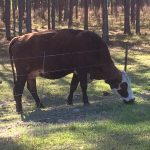
“I had to dig it to believe it, but I am capable of finding more than just turtle fossils at the Montbrook digging sight! First of all, I can’t emphasize enough how extraordinary it is to interact with free-roaming cows every time I arrive to this site. It allows for me to reflect upon the beauty of my natural surroundings. I started digging at 10am and it was nearly 1pm in a flash. I could not believe how quickly time flies by while uncovering fossils. Being my second visit to the site, I was able to grab my supplies and begin digging right away. Almost instantly I uncovered my first few turtle shell fossils. I was able to uncover almost a complete underside to a small turtle shell which was entrapped by a few other turtle parts. Along the way, I came across what I believed to be incredible finds. I had uncovered two alligator teeth.
“One a molar and another much sharper. I had no idea that alligators had back teeth that could be so rounded! Aside from that, I also ended up uncovering a spine to a fish vertebrae. It took time to convince me that this was a spine rather that some cool, long, skinny tooth. However, I was satisfied none the less.
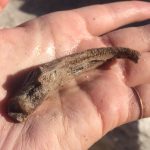
“After my lunch break I wanted to do what I felt was “clean-up” work in my section. The perimeter of my section was pretty poorly defined when I had arrived. While digging down and straightening one of the walls, I came across beautiful full pieces of fossils clumped together. Although I was unable to claim these fossils as my own because they extended into another section, I was satisfied in knowing that I could uncover their whereabouts for whichever lucky person is able to claim them. As the day was winding to a close and I was finally able to clear out mainly all dirt to create that clear boundary.
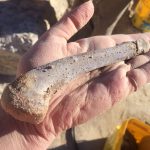
“After doing so, I uncovered two incredible fossils. First off, I was able to find a completely intact half of a fish jaw bone. Aside from that, right next to it I noticed another small piece of bone. I followed along the dirt trying to outline what the bone could be, and the fossil extended longer than I had originally imagined. It turned out that I ended up uncovering an alligator bone fossil. I was told that perhaps it could be the alligator tibia.Regardless, I was elated to be able to uncover the full piece of bone. What an amazing second dig at the Montbrook site. Yet again I left with a bag of fossils filled to the brim. I can’t wait to see what dig three has in store for me.” – Kelsea Rose
Sunday, March 19th
“Today was my first time back at the site in almost two months. I was amazed at the progress that had been made and how the pit had changed since I was last there. There were a lot more plaster jackets around the site than last time and we actually helped flip and transport 3 of them with a net into the van. Most of my day was spent digging around a gomphothere femur that had been plaster jacketed the week before. We needed a large enough space around the area so that we could flip the plaster jacket over for transporting. In this area, I found a few pieces of dorsal and ventral turtle shell, a piece of alligator spine, and some scales. After this, I dug underneath the plaster jacket to make flipping it over easier. Boy was it heavy! After the flip, I dug inside the jacket, above and around the femur, to try and lessen some of the weight for transport. The fossils I found weren’t as exciting as my first dig but it was interesting to learn more about the plaster jackets!” – Monica Sciturro
“Another day at the Montbrook Fossil Dig site! Today was a lot of fun, and I got to put to use a lot of the skills I learned the first time I attended. I was assigned a square plot of land on the opposite side of the dig site from where I was last time, which provided me with a bunch of new fossils to find! In this area, I found numerous pieces of fossils, which I identified as different parts of a turtle shell. To the right, is a picture of part of the underside of a turtle shell, which turned out to be the largest fossil I was able to excavate today. In addition to digging up fossils, I also got to help with a few plaster jackets!
“Unfortunately, I have yet to see one while it is being applied, but it was cool to see how they are removed from the ground and loaded into the van after they have set. One plaster jacket near us, pictured below, became another project for myself and another student. After we flipped the jacket over, we helped remove some of the dirt to make it easier to carry and to search for any extra fossils. Unfortunately, we didn’t find too many extra fossils, but it was an interesting and fun experience! I can’t wait til next time where I can continue making discoveries. I still can’t wait to hopefully see a plaster jacket application, as the process behind that fascinates me! Until next time!” – Charlie Bisbee
“Today I worked to lower my quadrate into the turtle death zone. For the first half of the day, I encounter no fossils as I quickly lowered the top sediment. However as I got deeper, I discovered some isolated turtle shell fragments. Eventually, I found something bigger. After some digging, I was able to remove a large part of a turtle shell.” – William Annis
“This was my first time back after having to miss my scheduled dig due to a very aggressive stomach bug and I was ready to dive in. I was a lot more familiar with the procedures and tools this time so the digging went a lot smoother and I was able to distinguished fossils from rock or clay with much more ease. I would say that the most exciting thing I found on this day was an alligator bone, but, in all honesty by the time I came across this there had been hours of mostly moving clay around and picking out turtle fragments. Don’t get me wrong – I appreciate turtles and I’m sure they’re very important to someone for a very scientific reason- but after digging out a couple dozen of these pieces the glamour wore off. Nonetheless, it was a great day and I was happy to be there because methodically digging through the clay turns out to be a pretty stress relieving activity in the midst of nights at the library and never-ending deadlines.” – Estefania Melo
Sunday, April 2
“Turtles, Turtles, and more… Oh my, a rhino bone?”
“My assigned square was right next to an unearthed Gomphotherium jawbone (they were trying to see how far it stretched), so I was feeling optimistic as I penetrated my first layer. This time I was much more aware of what clay and phosphoric rocks felt and looked like, so I avoided many encounters with false hope and saved myself a considerable amount of time. In no time, I found a plethora of turtle shells.
“They were fragile and broke from each other easily, but these finds kept me engaged in my square. After three hours, my screwdriver produced a clunk like it did with many other fragments of turtle shells. I cleaned the dirt away until what looked like the spiked edge of an alligator turtle shell (Macrochelys). I worked down and back slowly until a bone became free. Okay, I’m an expert on rocks now but I hadn’t seen something like this before. It was interesting with a potato like surface, considerable density and true symmetry, much more interesting than a turtle shell. I tried to hold back my excitement, but then they told me it was most likely a sesamoid from a juvenile ancient rhino-like species, Teleoceras. Cool… for five million years this was hidden!” – Alexandra Campione
Curious about the students next impressions of digging at Montbrook? Click for third, fourth, and soon-to-be fifth, and last, blog posts.


